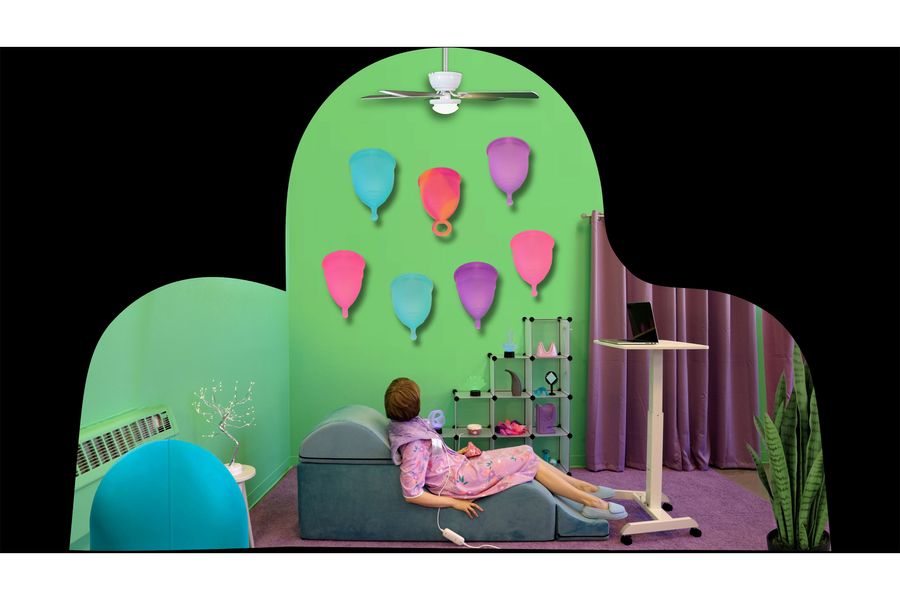
Cynthia lives alone and wears a lot of floral nightgowns. Sometimes her home is full of kitschy paintings of animals and trees, or crystals and sculptures of spiraling forms. She has a lot of stuff intended to ease and optimize: electric blankets, automatic lotion dispensers, exercise balls and bands. Cynthia loves her stuff. She touches her plasma globes often, with quiet satisfaction. But it’s more than just pleasure that she’s seeking. Through the things she acquires, Cynthia hopes to find meaning.
Cynthia is the alter ego of the artist Shana Moulton and a performance that’s been going on for 22 years. Moulton has now brought her to the Museum of Modern Art, in an installation titled “Meta/Physical Therapy,” on view through April 21. The darkened gallery glows with the warm, trippy light of six videos — including two projected on giant bell-jar/vase-shaped set pieces — and a sculpture that features a dozen neon lamps ascending to a rainbow halo. “It’s a critique of consumerism,” Moulton said to me at the museum, “but I’m critiquing myself and my own guilt around consuming and being a clueless white lady.”
In the show, the video narrative begins with Cynthia receiving an Amazon package. It arrives via a projected stream snaking along the floor of the gallery. The box contains a ceramic vase. Cynthia can’t figure out where to place it, so naturally, she Googles, “Where should I put my vase?”; the results stream out of the computer in a kind of virtual tidal wave. From there, the journey gets much weirder, as Cynthia has a vision of floating menstrual cups forming the Seven of Cups tarot card and then goes for a spin around town in a rolling personal steam-sauna tent, which crashes into a tree. Later, a water spirit guides her in physical-therapy exercises that correspond to the seven stages of alchemy, and she gets sublimated into solar energy.
Moulton comes across as a lot more normal: friendly but demure and maybe even quaint (“Oh my gosh,” she said several times). She looks different from Cynthia — no unflattering bob or bright makeup — but the eyes are the same. In her videos, Moulton uses those eyes to great comedic effect. Cynthia’s brow seems constantly furrowed; she can never quite get a handle on what’s going on.
“She almost has no agency. She’s sort of carried along this current of whatever’s happening to her,” Moulton said. “I feel similarly. Because the world today, all these things are happening to us, and we’re buying all these things or being advertised to. And I’m just going with the flow.” Many of us, though, including Moulton, are critical of our relationship to that flow; not so the guileless Cynthia, who represents a version of her maker that could have been, had she never left California or gone to art school. “That would be me alone, without ever becoming self-aware,” Moulton said, laughing.
Moulton’s parents owned a mobile-home park for seniors called Whispering Pines, in rural California, near Yosemite. Cynthia was originally a bit based, with affection, on the women who lived there and would invite Moulton over to their tchotchke- and bird-filled houses to do puzzles. Similarly, Moulton’s family styled their homes with finds from thrift stores and flea markets. Moulton’s mother, Vivian, made mosaics and amassed a collection of hand-shaped objects, some of which she displayed in her garden as a kind of gag, “so it looked like dead people reaching,” Moulton said.
Like her matriarchs, the young Moulton loved to decorate her bedroom with mass-produced items, but going to art school tested her relationship with them. “When you first go to art school, you’re like, everything sucks,” Moulton said. She renounced the kitschy aesthetic of her childhood as embarrassing for a while, until she had the idea for Cynthia.
Moulton was 13 when David Lynch’s Twin Peaks aired on ABC, and the now-cult-classic TV series “completely changed my life,” she said. Although she didn’t have a dark, secret second life of her own, she related to the girls at the heart of the show, living in a small town on the edge of the woods. Years later, when she was trying to come up with a title for her new art project, she chose Whispering Pines in homage to both her parents and Lynch (a ceiling fan plays a role in the MoMA show).
In early Whispering Pines, Cynthia was a sad sack who wore garments embedded with medical devices that Moulton had made. In the first video, she goes to the grocery store in a purple-and-white-striped dress with a perfectly positioned hemorrhoid pillow. Moulton’s embodiment of Cynthia has always been the heart of the project, whether in videos or live performances, where she interacts with the projections and uses her body to bridge the physical and digital realms. (If that sounds heady, note that in one performance she poured Pepto-Bismol over herself.) Moulton is planning a series of performances for MoMA in April with her frequent collaborator, the composer Nick Hallett. They’ll create a kind of medical ritual with a live band that leads Cynthia to a higher state of consciousness.
Cynthia has long sought spiritual alongside physical healing, but over the past decade, Whispering Pines has gotten more mystical. The videos have become sleeker and visually richer: Third-eye imagery abounds as she walks labyrinths and spirals and is visited repeatedly by a singing sphinx. Moulton is fascinated by New Age practices — the biography on her website is an image of her birth chart drawn by her uncle — but not devoted to any of them. “I used to think of this as a project to find my spirituality, but I don’t think that’s ever going to happen,” she said. “This is it: Art-making is the spirituality.”
In Whispering Pines, the items in Cynthia’s home open up portals or lead her to other places or dimensions, where she experiences some kind of revelation or enlightenment. But by the next episode, she’s back where she started, seemingly no wiser.
At first, I saw this as a Sisyphean failure loop, a commentary on the superficiality of quick-fix American consumer culture, especially the way things are marketed to women. I myself felt stuck in that loop a few nights after my interview with Moulton, as I sat on my couch scrolling exasperatedly through recommendations for wrist braces; two previous purchases had failed to ease my carpal tunnel symptoms. When nothing seemed right, I self-soothed by splurging on an expensive ergonomic footrest. Moulton had told me that she would buy all the beauty products advertised to her if she could. “I’m still looking for one that is going to do everything it promises,” she’d said. Aren’t we all?
Erica Papernik-Shimizu, the MoMA curator of the show, described Whispering Pines to me as an “optimistic critique, without an ounce of cynicism.” And it’s true that the flip side of constant failure is opportunity. Starting over means the chance to try again. We may laugh at Cynthia’s naïveté, but there’s something inspiring in her earnestness. She’s willing to give almost anything a shot. She knows that enlightenment can be found anywhere, if only you’re willing to look.



